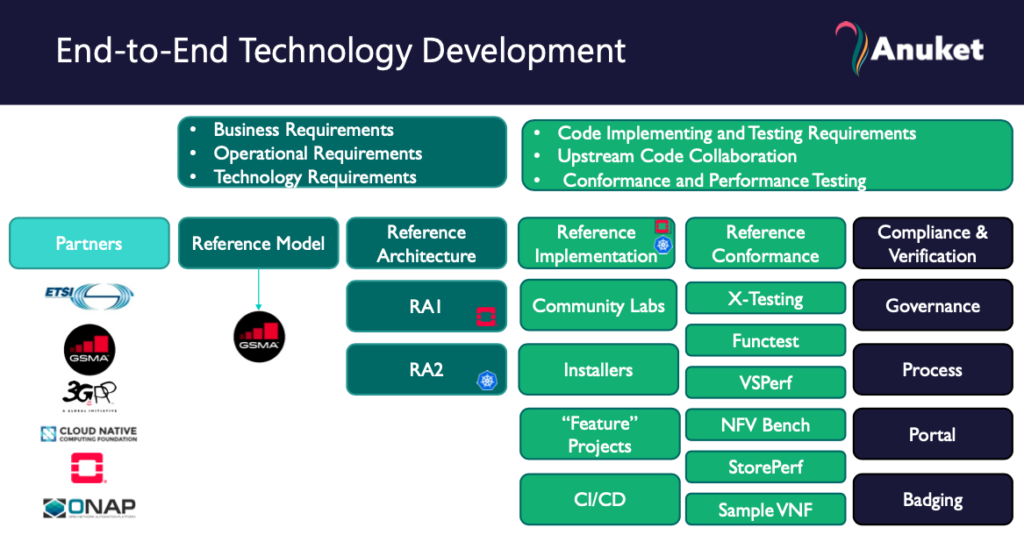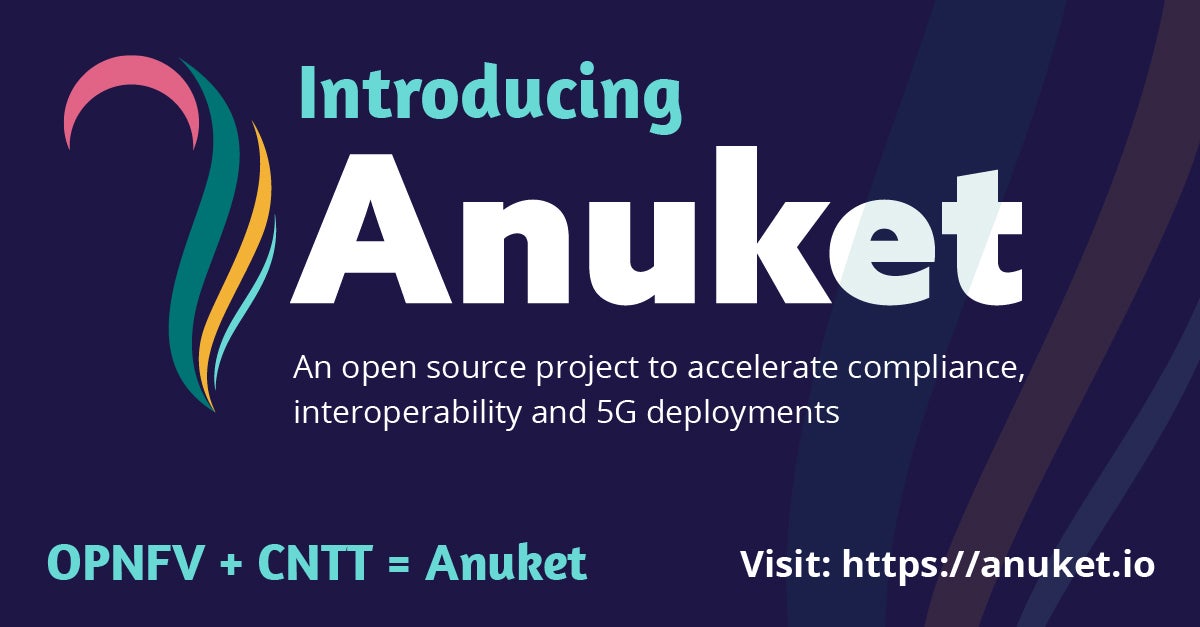- OPNFV and CNTT merge to form Anuket, enable rapid deployment of cloud native and virtual network functions (CNFs & VNFs), infrastructure, and services
- Anuket unifies global ecosystem of telecom operators, vendors, and systems integrators into a de facto open community with over 100 organizations participating to date
- New project facilitates seamless lifecycle management for integrating requirements, architecture, specifications, implementation, testing and deployment of Telecom Network Infrastructure
SAN FRANCISCO– January 27, 2021 – LF Networking (LFN), which facilitates collaboration and operational excellence across open source networking projects, today announced the creation of the Anuket project. A merger of CNTT (The Cloud iNfrastructure Telco Taskforce, which provided reference models and architectures for both virtual machine and containerized network functions) and OPNFV (the Open Platform for NFV, which reduced time to integrate and deploy NFV infrastructure and onboard VNF/CNFs), Anuket tools and artifacts empower the global communications community to deliver compliant network services faster, more reliably and securely, and accelerate the transformation to cloud native infrastructures.
Anuket delivers standardized reference infrastructure specifications and conformance frameworks for virtualized and cloud native network functions, enabling faster and more robust onboarding into production, reducing costs, and accelerating telecom digital transformation. By continuing OPNFV’s legacy of operating upstream with collaboration across other open source projects (such as LF Networking, LF Edge, CNCF, LF AI, ODIM and other industry organizations and standards bodies) and CNTT’s operator focus, the project ensures technology meets business and operational needs. Anuket will also preserve CNTT’s close working relationship with GSMA, who will continue to publish the project’s Reference Model work.
“It’s incredible to see the evolution of what began as the Open Platform for Network Functions Virtualization over six years ago,” said Heather Kirksey, vice president of Community and Ecosystem Development at the Linux Foundation. “With Anuket, we are making it easier and more efficient for CSPs to transform their networks and save money, with one, end-to-end platform.”
“The Anuket project is unique in covering Operator requirements collection and normalisation, subsequent open-source software development, through to Industry certification programs of ecosystem implementations, all under a single initiative,” said Walter Kozlowski, Anuket Technical Steering Committee co-chair and Principal, Cloud Infrastructure Architecture, at Telstra. “I am proud to serve in the role of a co-chair of its Technical Steering Committee, and I am excited by the unique opportunity this project creates for my company and for the whole industry, in the area of network transformation and related telco open infrastructure.”
Moving Forward
The project will build on the long-standing success of each community’s output. OPNFV’s final stand-alone release, Jerma, delivered in December, delivered CNTT-ready capabilities, including an initial cloud native Reference Implementation and integration of cloud native testing aligned with CNTT’s R2 work. Elbrus, CNTT’s final release, planned by early February, initiates a number of new work areas, including infrastructure automation and observability, hardware management, and hardware abstraction and network fabric programmability. These topics will be crucial to ongoing operational scalability, especially as edge deployments become more common. This work will continue to drive implementation and testing project code in future Anuket releases. To get involved in Anuket and help build the future core infrastructure for the global communications ecosystem, visit https://anuket.io.
LF Networking will be hosting a virtual Developer & Testing Event February 1-4 to work on project releases, discuss project architecture, direction, and integration points, and further innovation through the open source networking stack. The Anuket track will focus on the Reference Architectures and Reference Model and address implementation considerations for the OPNFV Verification Program (OVP). For details and registration, visit: https://www.lfnetworking.org/event/lfn-developer-testing-event-february/
Additional Member Support
AT&T
“I’m very excited about the merging of CNTT and OPNFV into a single entity,” said Andre Fuetsch, CTO, Network Services, AT&T. “This move will empower the global communications community by bringing together reference cloud infrastructure models and architectures with conformance programs and tools to deliver network services faster, more reliably, and securely. The collaborative spirit of this open source development effort will help grow the communications industry to new levels of service for all stakeholders. Empowering the global society to benefit. We at AT&T are proud to be part of this initiative and look forward to supporting Anuket in the coming years.”
Huawei
“Huawei expects the merging of CNTT and OPNFV into Anuket can further help align the understanding of NFV infrastructure and evolve the existing technologies to better adapt cloud native and Telecom needs,” said Uli Klener, chief standardization expert, Huawei.
Intel
“As the telecom industry continues the rapid transformation to cloud native technologies and virtualization fueled by 5G, Anuket’s merging of OPNFV and CNTT initiatives is another important way to help provide the predictability operators need to efficiently deploy new services,” said Rajesh Gadiyar, vice president and chief technology officer of Intel’s network platforms group, and LFN board member. “Intel has been at the forefront from the beginning, leading in governance, promotion, requirements and code contributions, working with the community to realize the vision of Anuket while optimizing our network portfolio of processors, accelerators, memory, and software for an enhanced customer experience and performance.”
KDDI
“CNTT dramatically improves the efficiency and productivity in onboarding and deploying VNF/CNFs, accelerating network transformation and lowering TCO, by defining a reference infrastructure model for telcos and other communication service providers,” said Toshiyasu (Toshi) Wakayama, manager, European Research Office, KDDI. “Now Anuket, with combination of CNTT’s definition role and OPNFV’s verification / conformance tests developing role, will undoubtedly and effectively accelerate realisation of CNTT’s concept, which is essential in the 5G era and beyond.”
Mirantis
“Standardizing on the basic architecture and ways in which CNFs and VNFs interact with our infrastructure has provided us with a serious advantage,” said Shaun O’Meara, Global Field CTO, Mirantis. “Our customers can spend a minimum amount of time onboarding new capabilities, and we can focus on adding value beyond the commodified underpinnings of that infrastructure, such as Kubernetes or OpenStack.”
Orange
“Orange is a founding member and major contributor of CNTT and was also the first contributor of OPNFV,” said Stéphane Demartis, vice president, Cloud Infrastructure Solutions and Services at Orange. “Today, we leverage it in our internal telco IaaS, which is already CNTT compliant, and request compliance in sourcing. We are totally convinced that the strengths of CNTT and OPNFV together will produce greater synergy to go further. With this merger, Anuket will reach the size and breadth necessary to drive the industry towards an efficient, interoperable cloud infrastructure for telecom services, benefiting the entire industry, developers, vendors, integrators and operators.”
Saudi Telecom Company
“The Anuket project will be a game changer of how Telcos think about the cloud, and it will accelerate the adoption of cloud platforms inside Telcos; this will enable integration of the best from both CCNT and OPNFV,” said Ahmed El Sawaf, technical director, Network Transformation and Cloud Infrastructure, STC. “Where CCNT succeeded to achieve a reference model and reference architecture, while OPNFV achieved reference implementation and reference conformance to have an E2E view on how the cloud should be built.”
Verizon
“As we launch Anuket by melding CNTT with OPNFV I am excited to see the project moving into the next development stage, taking reference architectures and models translating them into implementations and conformant platforms,” said Beth Cohen, Cloud Technology Strategist, Verizon. “I am looking forward to being able to use Anuket conformance as a way to simplify and speed our vendor on-boarding processes.”
About The Linux Foundation
The Linux Foundation is the organization of choice for the world’s top developers and companies to build ecosystems that accelerate open technology development and industry adoption. Together with the worldwide open source community, it is solving the hardest technology problems by creating the largest shared technology investment in history. Founded in 2000, The Linux Foundation today provides tools, training and events to scale any open source project, which together deliver an economic impact not achievable by any one company. More information can be found at www.linuxfoundation.org.
The Linux Foundation has registered trademarks and uses trademarks. For a list of trademarks of The Linux Foundation, please see our trademark usage page: https://www.linuxfoundation.org/trademark-usage.
Linux is a registered trademark of Linus Torvalds.
 As the Anuket Project’s first release, Kali benefits from the combined expertise and contributions from the two organizations that merged early this year: the Open Platform for NFV (OPNFV) open source project in LFN and the Cloud iNfrastructure Telco Task Force (CNTT). Many work streams developing Reference specifications and projects developing implementations, testing utilities, telemetry collection and management, and other capabilities comprise the Kali Release.
As the Anuket Project’s first release, Kali benefits from the combined expertise and contributions from the two organizations that merged early this year: the Open Platform for NFV (OPNFV) open source project in LFN and the Cloud iNfrastructure Telco Task Force (CNTT). Many work streams developing Reference specifications and projects developing implementations, testing utilities, telemetry collection and management, and other capabilities comprise the Kali Release.
 So, what is new in Elbrus?
So, what is new in Elbrus?